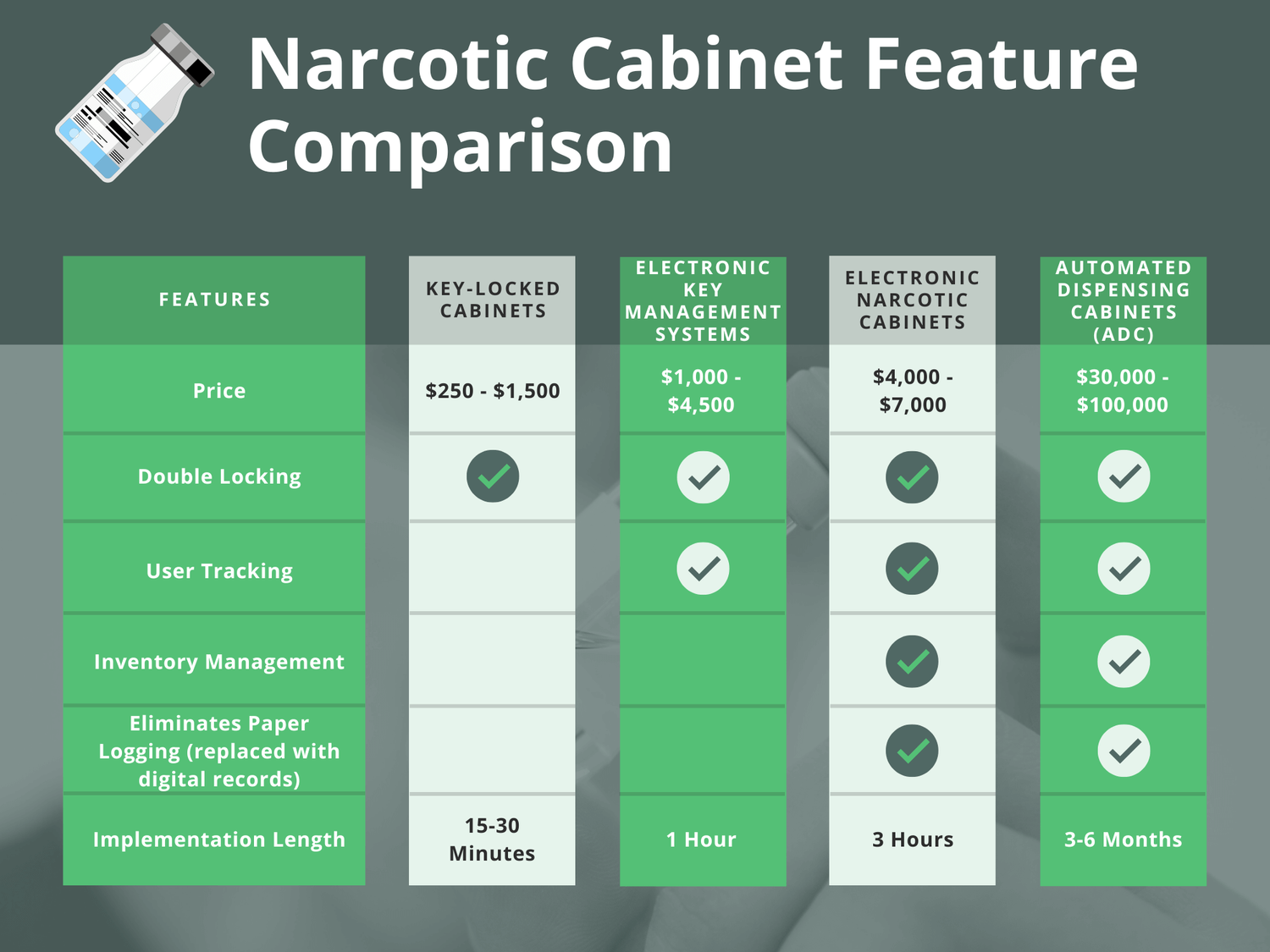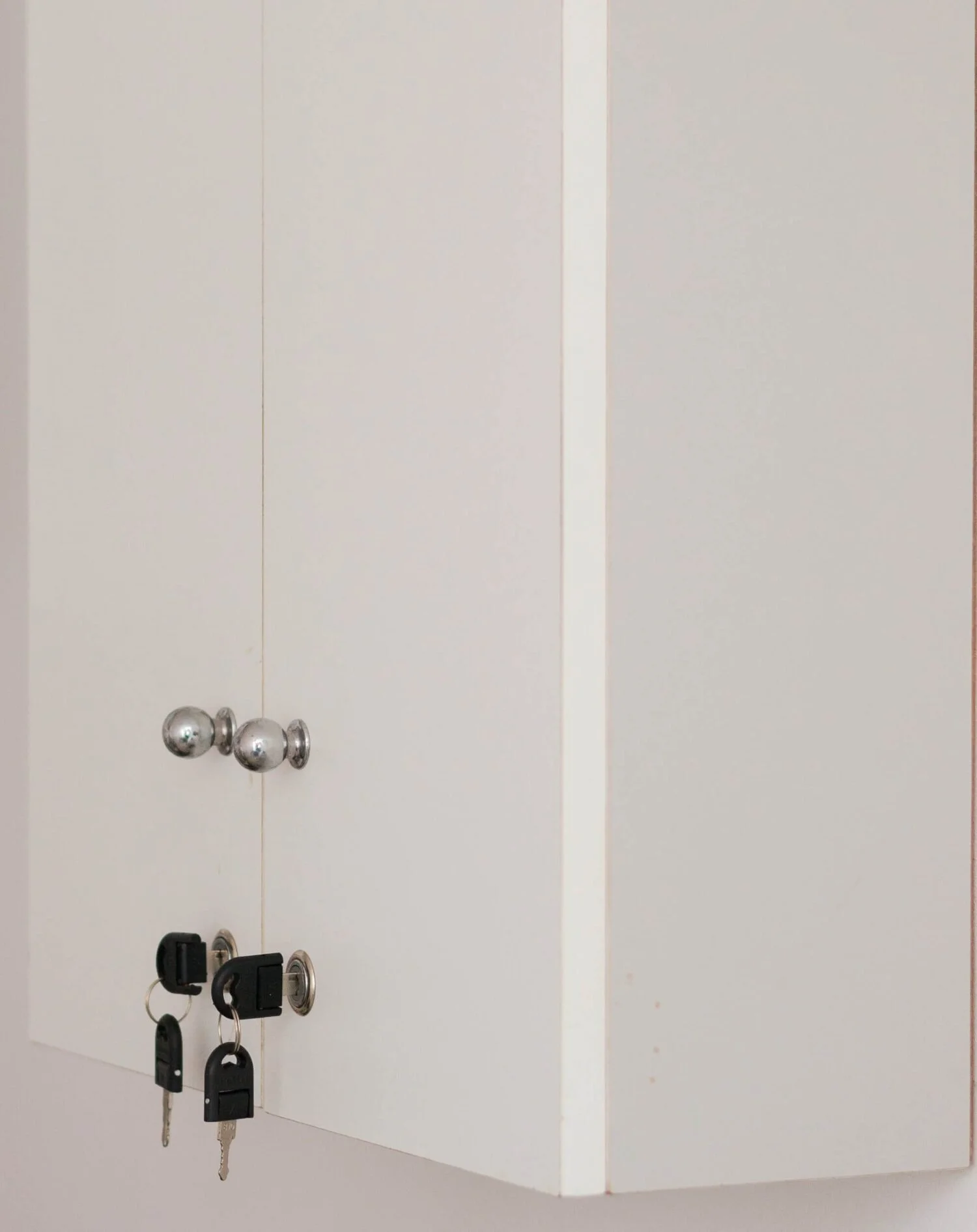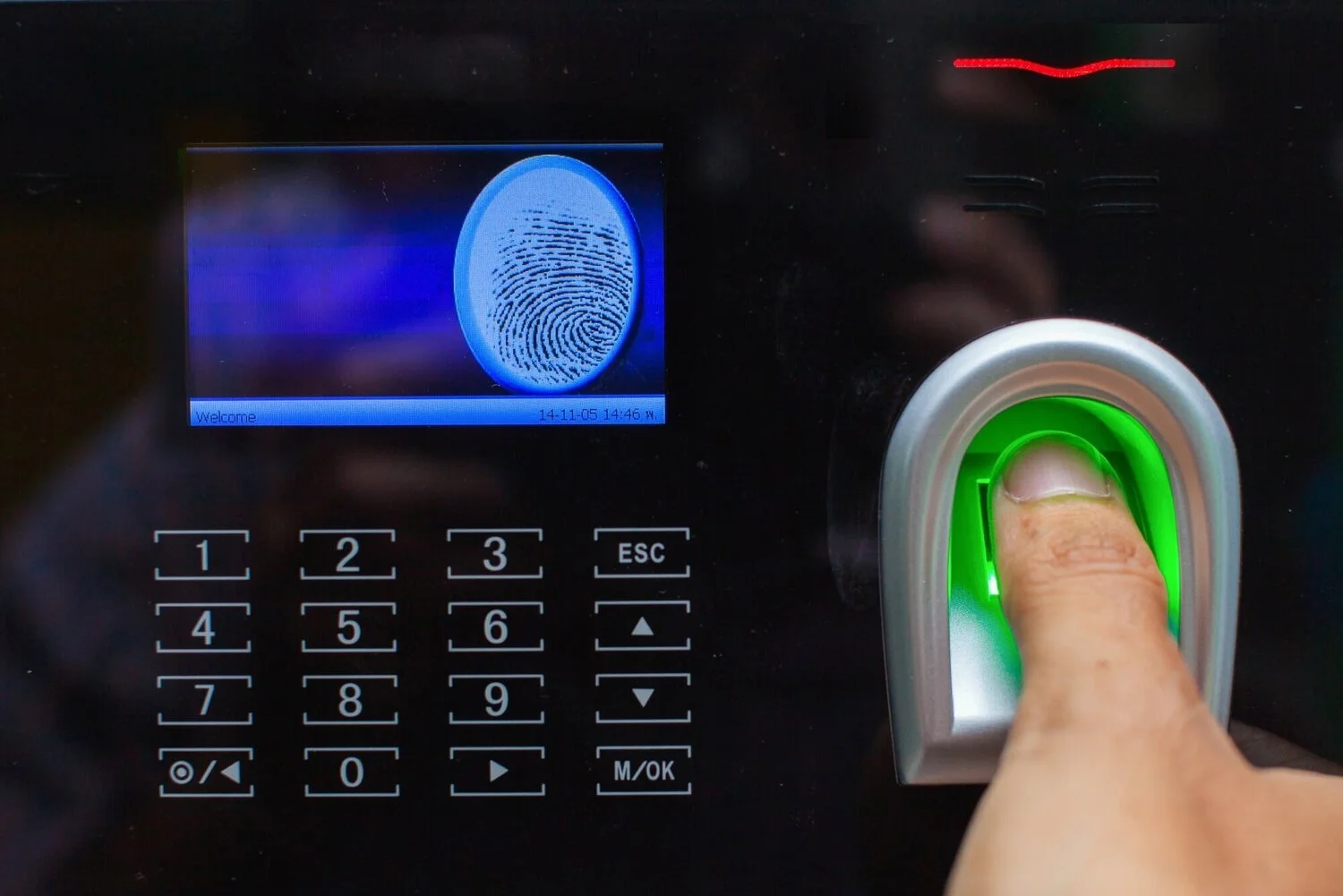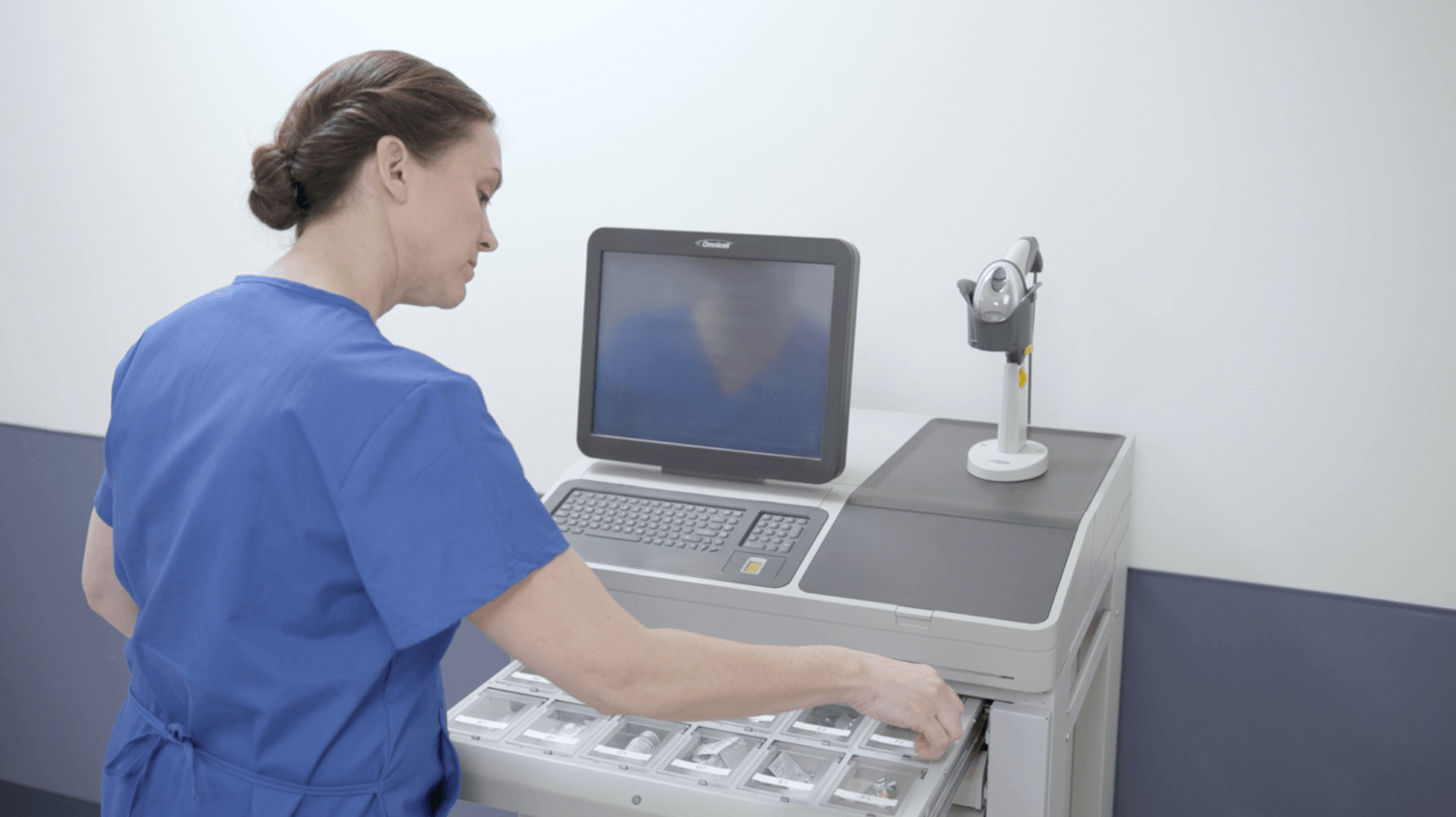The Locking Medicine Cabinet Buyer’s Guide
The Four Types of Lockable Medicine Cabinet in the Market Today
When in the market for a locking medicine cabinet, you have several options tailored to suit your facility's needs and budget. Understanding the nuances of each type can help you make an informed decision that aligns with your operational requirements. Lockable medication cabinets vary widely in cost, ranging from affordable conventional dual-key metal lockers to sophisticated electronic systems equipped with digital tracking and inventory management capabilities. And while they might have all the bells and whistles, it does come at a price. A single unit can easily cost more than $100,000.
Between that $100-$100,000 price tag, there’s a variety of other options as well. These options offer different solutions based on what markets and types of facilities they focus on.
1) Key-Locked Cabinets
So to start off, let’s focus on the cheapest solution: the key-locked cabinets. Key-locked cabinets can get as low as $100 per unit. However, you’re likely looking at somewhere between $250 to $1,500 for a majority of the cabinets on the market. However, you can easily find large lockers that will cost closer to $3,500. The main benefit of these cabinets is definitely the cost. For many small facilities with 1 - 4 staff members, cabinets like these can often be the best fit.
While these cabinets may be excellently cheap compared to the competition, the lower price does come with some major setbacks. The most obvious issues are lack of security and organization. For DEA compliance, narcotic cabinets require a double-locking system. The cabinets in this first category easily meet this requirement by using dual locks that require two separate keys to open the cabinet. It’s the most affordable way to ensure double locking, but the two keys present issues. The keys can easily be misplaced. This can lead to staff scrambling to find them when it’s urgent. As a result, what often happens is that the cabinet simply remains unlocked for large portions of the day. Or, the keys are left in an open area for quick access by staff. Both of these common situations are not compliant with DEA regulations. If an auditor were to witness any of these practices, it would likely result in unwanted consequences.
In addition, with keys, it’s very difficult to entrust a single employee. Often, the facility designates a manager to secure the keys. This can lead to an issue of trying to track down that staff member. If they happen to be offsite, then you’re in even more trouble. On top of that, it’s more difficult to track access to the cabinet by staff. Without electronic authentication, when anyone goes into the cabinet, it can only really be tracked by paper. Even then, paper systems can be tampered with, especially when narcotics are involved.
Admittedly, we understand how critical we sound about key-locked cabinets right now. But it’s important to be wary of their deficiencies. Most users of key-locked systems understand where the cabinets fall short. In the past, there weren’t many other options available because the electronic options were much too expensive and designed for the hospital setting. However, in recent years, this has begun to change. More affordable alternatives have entered the market. But again, for very small operations with only 2 to 5 staff members, key-locked systems can sometimes be the best bet.
Prominent companies:
Harloff
Universal Medical
2) Electronic Key Management Systems
The second category is a bit more expensive than the key-locked cabinets, sitting at about $1,000 - $4,500. These products do have some limited electronic functions. We use the term ‘Electronic Key Management Systems’ for this category because these products focus specifically on the electronic keys to access the narcotics. They do not track or log any of the narcotics themselves, which is why they’re the least expensive digital option.
While these systems don’t keep running counts of your narcotics, they still see which users access the cabinet. Usually, these cabinets use electronic dual locking through pin codes, fingerprint scanning, or RFID (badge scanning or key fob) technology. As a result, administrators can look at reports of who accesses the cabinet. Overall, it can be very helpful for security, knowing keys are less likely to be left around. However, pulling the reports does not provide as much value. As the records do not replace your DEA-required paper logs because they won’t be able to connect the inventory to the staff or destination of the narcotic. So the reports remain incomplete. Again, systems in this category don’t keep running totals of your drug inventory, and they don’t track where each specific medication is going. This makes tracking down discrepancies through the user access reports not all that viable.
Another thing to check for, if this system falls within your budget range, is to ask about user caps and memory life. Many of these systems can only hold a certain number of total users on it. From our perspective, this is an oddity because with the simplicity of the data being stored, holding near-infinite user numbers shouldn’t be very difficult. The other digital solutions that we’ll talk about next don’t have issues with user counts. They simply just aren’t a concern as technology has come so far that holding a very large amount of user data is easily manageable. In addition, some of these systems have it set so that the user records are accessible for a certain amount of time, perhaps a month or so, and then the records are wiped. Again, with the other higher tiered solutions, you won’t have this concern.
We have seen these solutions implemented successfully within ambulance services, where small units will be placed within the ambulance vehicle itself. In our opinion, key management systems aren’t really a great fit for narcotics. They’re much more applicable to medications that are valuable but don’t require the detailed recording that narcotics do. Their main contribution is simply doing a better job of allowing access to the specific staff members that you want, compared to standard keys. However, this option will fall short if you have any desire to know what meds your staff are pulling/adding or wasting. We find that many facilities that handle narcotics want to track where that specific med is going, whether that’s to a specific patient or moved from one location to another. When that happens, they also want to know which specific user performed that action. Many regulatory bodies, not just the DEA, require that all of this be recorded. So, that’s where the major deficiency stems from with electronic key management systems.
Prominent Companies:
Knox Box
Healthcare Logistics
3) Digital Narcotic Cabinets
Next comes the category that our cabinets fall under. MedServe’s digital narcotics cabinets go one step further than electronic key management systems by keeping inventory counts of any drugs within the cabinets. The system tracks user activity as staff use either an ID badge or a unique PIN code to access the cabinets. Then once they’ve logged in, they specify exactly how much they’re taking and the particular destination of the drug. That destination could be to a patient, a new location, to a fellow employee, etc.
So, users can perform a variety of functions. These actions include withdrawing, stocking, returning, and wasting narcotics. Staff members can also perform AM/PM cycle counts. Any of these tasks can be witnessed with digital verification as well. All of these transactions are recorded electronically and stored securely on the cloud. This activity then automatically creates digital reports that an administrator can access from any web browser. As a result, these reports replace the paper logs that are required for narcotics. In addition, administrators can edit cabinet, user, and drug settings from their computer or tablet using the cloud interface.
Like the electronic key management systems mentioned above, the cabinets can be digitally double-locked. However, our system differs in how it’s accessed. Our cabinets have individually locking compartments that can hold multiple items in each. This helps separate certain schedules of narcotics and also increases security. Most previously mentioned narcotic cabinets do not have compartments that are locked off separately. For most other cabinets, once you unlock the doors, you have your pick of everything. This makes it difficult to have your narcotics stored along with other medications or supplies in many circumstances.
Essentially, our system serves as the middle ground between a key-locked cabinet and the complex digital systems found in hospitals (which we’ll dive into shortly). Our narcotic cabinets aim to give facilities outside of the hospital space the ability to upgrade from rudimentary key-locked cabinets to electronic tracking and security at a price point that’s actually feasible. With prices ranging from $4,000 - $7,000, our system remains incredibly more cost-effective than the last category that we’ll discuss which is automated dispensing cabinets.
Prominent Companies:
MedServe (formerly CareDirect)
4) Automated Dispensing Cabinets (ADCs)
The last category is an automated dispensing cabinet, also known as ‘ADC.’ These are the most robust systems within the narcotic cabinet ecosystem. In today’s healthcare setting, it’s nearly impossible to find a hospital that doesn’t use ADCs to store their narcotics and other medications. While only a few players dominate the hospital space, automated dispensing cabinets can be found in other settings outside of the hospital. However, in general, it’s quite rare to see because of the price and complexity of these systems.
Moreover, automated dispensing cabinets are very intricate and take months to get up and running properly. Even more crucially, they range between $30,000 - $100,000 for a single unit over a 5-year window. On top of that, automated dispensing companies require contracts for their systems that usually extend through those 5 years. Over that time period, there are upfront costs and monthly subscriptions that are required for software updates and general maintenance of the cabinets. After the initial term, you’ll need to renegotiate a brand-new contract. The big issue there is that the large subscription fees will continue, and they can potentially increase. It’s also important to keep in mind what your equipment’s end-of-life is. Many ADC brands only support older models for a relatively short amount of time. As a result, there’s a chance after the first contract, a facility will be required to purchase a new model.
These high costs don’t come without reward though. Automated dispensing cabinets are trusted within the healthcare industry and are present in virtually every hospital. Healthcare systems rely on ADCs to integrate with their other numerous tech platforms as often as possible so that nurses and pharmacies can work together to keep hospitals running smoothly with their busy patient loads.
Still, the hefty costs of ADCs are something most facilities that handle narcotics can’t fit within their budget unless they are a hospital themselves. There are some large, non-hospital-based facilities that can handle these fees. But for most, it’s simply not an option. Luckily, narcotics storage often does not need the heavy-duty tracking that hospitals require.
Prominent Companies:
Pyxis
Omnicell





